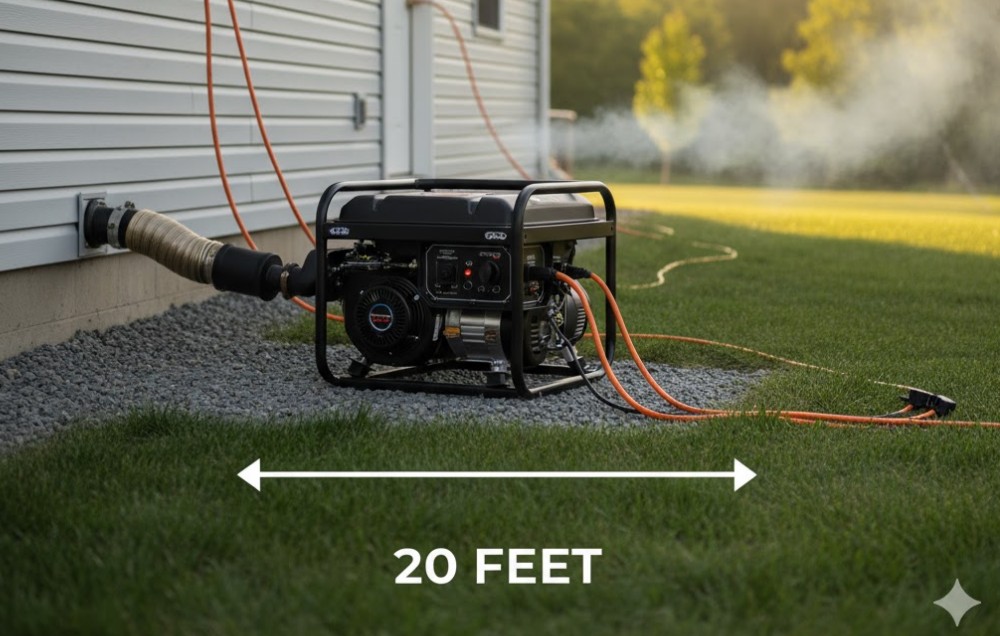Whether you rely on a generator for emergency backup power or daily operations, its efficiency, longevity, and—most importantly—safety hinge on one critical factor: proper ventilation for generators. Often overlooked, ventilation is not just about keeping the machine cool; it’s a multifaceted system that manages deadly exhaust gases and maintains the optimal operating environment for the unit. Neglecting this aspect can lead to overheating, engine failure, and catastrophic carbon monoxide poisoning. This comprehensive guide will walk you through the essential elements of generator ventilation for both portable and standby units, ensuring you meet safety standards and maximize your investment.

Why Proper Ventilation for Generators is Non-Negotiable
A generator is essentially a powerful internal combustion engine connected to an electrical output. As with any engine, it produces two major byproducts that must be managed: intense heat and toxic exhaust gases. Therefore, proper ventilation for generators serves three fundamental purposes:
1. Exhaust Gas Management: The Safety Imperative
The most critical role of ventilation is the safe expulsion of carbon monoxide (CO). This colorless, odorless gas is a byproduct of combustion and is lethal even in small concentrations. Because of its extreme danger, preventing the accumulation of CO is the single most important safety consideration. In fact, CO is classified among the highly toxic gases that demand meticulous control. Learn more about highly toxic gases here.
Furthermore, the exhaust system must be designed to direct these fumes far away from human and animal habitation, including doors, windows, and air intakes. Failure to do so can quickly turn a power outage into a deadly scenario.
2. Cooling: Preventing Engine Overheating
Generators generate significant amounts of heat during operation. If this heat isn’t effectively dissipated, the engine and alternator components will overheat. Excessive heat can cause:
- Decreased efficiency and performance.
- Premature wear and tear on engine parts, leading to early failure.
- Potential damage to the electrical components of the alternator.
- Triggering high-temperature shutdowns, rendering the generator useless when you need it most.
The cooling air must be continually drawn in and passed over the engine and alternator before being expelled. Consequently, the volume of air required for cooling is often much greater than the volume required for combustion.
3. Combustion Air Supply
An engine needs a constant supply of fresh air to mix with fuel and burn effectively. If a generator is placed in a small, enclosed space without adequate air intake, the engine will eventually starve for oxygen. This leads to poor fuel combustion, reduced power output (or “derating”), and the production of more soot and harmful emissions.
Ventilation Requirements for Standby (Fixed) Generators
Standby generators, typically housed in a permanent enclosure or a dedicated room, have the most stringent ventilation requirements. They operate under various codes and standards, such as those set by the National Fire Protection Association (NFPA) and local building codes.
The Concept of Airflow Balance
The goal is to achieve airflow balance—the volume of air entering the enclosure must equal the volume of air leaving it. This is typically accomplished with two main ventilation points:
1. The Air Intake System
The intake louver draws in fresh air from the outside. This air serves the dual purpose of feeding the engine’s combustion process and cooling the engine and alternator. The size of the louver and ductwork is crucial. Generally, the opening must be large enough to allow the required airflow at a low velocity, minimizing static pressure drop.
2. The Air Discharge System
The discharge louver expels the heated cooling air. This is often an automated louver connected to the generator’s radiator. It’s essential that the hot discharge air does not immediately recycle back into the intake, which would compromise the cooling efficiency. Therefore, there must be adequate distance between the intake and discharge openings.
Exhaust Piping and Mufflers
Separate from the cooling air, the engine’s exhaust gases must be routed outside via a robust, leak-free pipe system. This system includes the muffler, which dramatically reduces noise. Key considerations for the exhaust system include:
- Material: Use high-grade materials (like schedule 40 black iron pipe) that can withstand extreme heat.
- Insulation: The exhaust pipe, especially within the generator room, must be insulated to prevent heat transfer into the space, which would reduce cooling efficiency and pose a fire hazard.
- Termination: The exhaust pipe must terminate far enough away from the building and above ground level to prevent fumes from re-entering. Check local codes for minimum distances, which often exceed 5 feet from any opening.
Ventilation Best Practices for Portable Generators
Portable generators present unique challenges because they are often used temporarily by non-professionals. The primary rule is simple and absolute: NEVER run a portable generator indoors. This includes garages, sheds, carports, basements, or any other enclosed or partially enclosed space. The risk of CO poisoning is too high.
The “Safe Distance” Rule
Even when used outdoors, a portable generator must be positioned correctly. Specifically, it should be placed at least 20 feet (6 meters) away from the home or structure, with the exhaust outlet pointed away from the building. This distance helps ensure that the wind doesn’t inadvertently carry exhaust fumes into the home through windows, vents, or other openings.
Protection from the Elements vs. Ventilation
Users often try to shelter their portable generators from rain and snow, which is necessary to prevent electrical hazards and damage. However, this is where ventilation mistakes frequently occur. Using an enclosed shelter, like a doghouse or a makeshift lean-to, can trap CO and heat. Instead, use a dedicated, open-sided generator cover or running tent. Find the best generator covers that allow proper ventilation here.
Safe Electrical Connections
To maintain the required distance, you must use a heavy-duty, outdoor-rated extension cord. Ensure you have the right extension cords for safety and power transmission.
A Step-by-Step Guide to Calculating Ventilation Needs
For standby units, calculating the precise airflow is a job for a qualified HVAC or generator professional, but understanding the basic principles is vital for facility managers and homeowners.
The Essential Data Points (Heat Rejection)
The primary factor is the amount of heat the engine rejects into the surrounding space. This figure, often measured in BTU/hour, is provided by the generator manufacturer. Crucially, the required ventilation airflow (measured in cubic feet per minute, or CFM) is determined by this heat rejection and the acceptable temperature rise inside the enclosure.
1. Determining Required Airflow (CFM)
Manufacturers provide two key CFM numbers:
- Radiator Fan Airflow: The air moved by the radiator fan, which dictates the cooling requirements.
- Combustion Airflow: The much smaller volume of air needed by the engine for burning fuel.
The total required intake air must be at least the sum of these two figures, plus a safety margin to account for pressure drops from louvers and ductwork. Consequently, the total louver free area must be calculated to handle this CFM at a safe air velocity (typically less than 700 feet per minute).
2. Accounting for Air Density and Altitude
Air density decreases at higher altitudes and temperatures. Less dense air is less effective at cooling and provides less oxygen for combustion. Therefore, a generator at high altitude will require a larger ventilation opening or a faster fan speed to move the equivalent mass of air.
Maintenance and Inspections: Keeping Ventilation Optimal
Even a perfectly designed system will fail if it’s not maintained. Regular inspections are key to ensuring the ventilation system remains unobstructed and functional.
Vents and Louver Maintenance
Over time, louvers and air intake screens can become blocked by dust, debris, leaves, snow, or even nesting birds. This significantly reduces the airflow, leading to overheating. A simple, regular visual inspection can prevent this. Schedule professional generator inspections to catch deeper issues.
Exhaust System Integrity
Vibrations can loosen joints and connections in the exhaust pipe, leading to dangerous leaks of CO within the enclosure or room. Periodically check all welds, clamps, and gaskets for signs of soot or leakage. Any leaks must be repaired immediately to maintain safe operation.
Temperature Monitoring
A functional ventilation system maintains a stable operating temperature. If a standby generator begins to consistently run hotter than normal, it is a definitive sign of a ventilation problem, often a restriction in the airflow path. This early warning should trigger an immediate system check.
Regulatory Compliance and Safety Measures
To ensure proper ventilation for generators, adherence to local and national codes is mandatory. Always consult the manufacturer’s specifications and your local authority having jurisdiction (AHJ).
The Role of Carbon Monoxide Detectors
For portable generator use, installing battery-operated carbon monoxide detectors with an alarm is a life-saving necessity. Place them near sleeping areas and ensure they are tested regularly. They are your last line of defense against a deadly ventilation failure.
Sound Attenuation and Ventilation
Sound attenuation is another consideration. To reduce noise, some enclosures use elaborate ductwork or baffles, which inherently restrict airflow. Therefore, the ventilation calculation must account for the pressure drop caused by any noise-reducing components. You cannot sacrifice cooling and safety for a quieter operation; the design must balance both.
Final Thoughts
Understanding and implementing proper ventilation for generators is not just a technical detail; it is a foundational pillar of operational safety and equipment reliability. Whether you are installing a fixed standby unit or setting up a portable generator for an emergency, always treat the ventilation system as a critical component, not an afterthought. By ensuring a continuous supply of cool, fresh air and a reliable path for toxic exhaust and heat to escape, you protect your people, your property, and your investment, guaranteeing that your generator is ready to perform when you need it most.
Amranul is a highly experienced product review writer with a passion for helping readers make smart, informed purchasing decisions. Since 2018, he has specialized in thoroughly researching and analyzing a wide range of products to deliver honest, in-depth reviews. Amranul combines technical accuracy with clear, engaging writing to break down complex product features and highlight true user value. Look for his reviews to find reliable information and expert insights you can trust before you buy!





